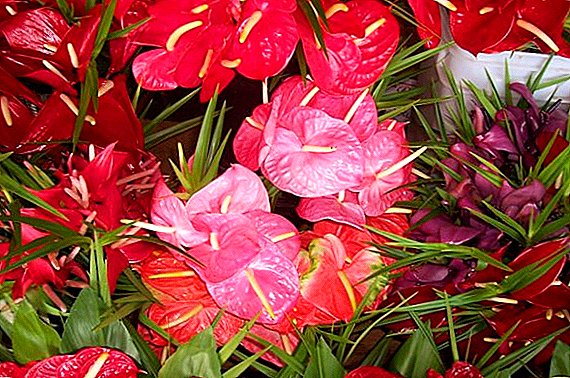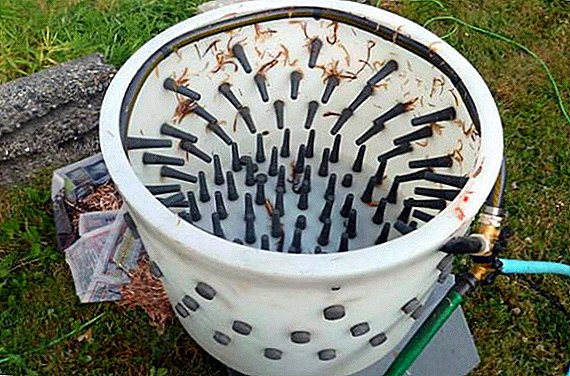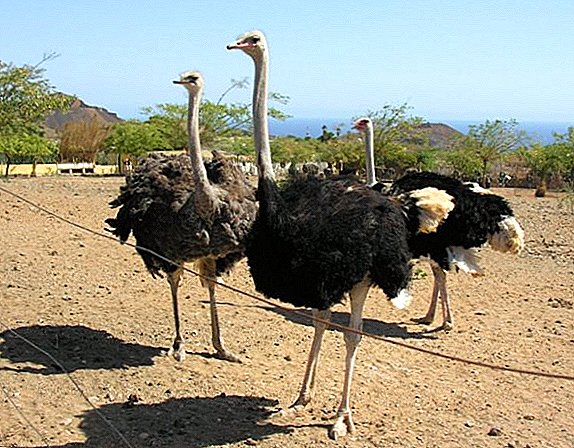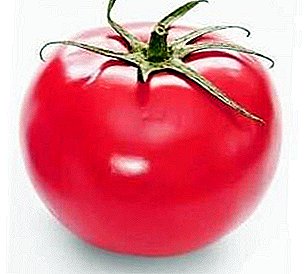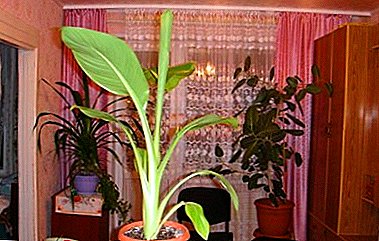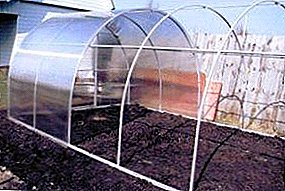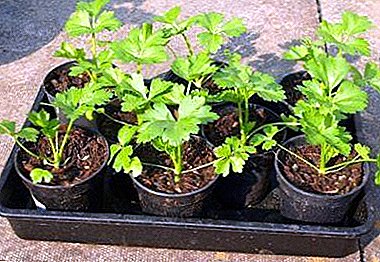
Good news for lovers of greens: juicy parsley can be cultivated not only with the help of seeds, but also in a seedling way!
The time-consuming process is very efficient. Given the technology of planting, you can get early vitamin green of excellent quality.
Let's take a closer look at all the features of this method and find out whether it is possible to plant any varieties of parsley in a seedling way, how to plant seeds correctly and when to transplant the seedlings obtained in open ground.
Can I use this method?
Growing green seeds - a common method among gardeners, but for getting early parsley it is recommended to apply another method - cultivation through seedlings.
Greens are grown with two methods:
- Sow the seeds in the tank, and then roll them over with the ground, without disturbing the root system of plants.
- Get seedlings immediately in pots, and then transplanted into the ground (cultivation with open root systems).
When transshipment to the beds of seedlings grown by the first method, greens continue to grow without significant changes. In the second method of cultivation, parsley, moved to the site, for some time, adapts to new conditions.
Important! With the help of seedlings, lush greens are obtained earlier, about 1.5 or 2 months faster than from seeds planted in the ground.
Advantages and disadvantages
The seedling cultivation method has many advantages. These include:
- The collection of abundant and early greenery, which differs from the harvests obtained by sowing seeds of parsley in open ground.
- The use of smaller planting areas, as a result - the creation of optimal conditions for seedlings for development.
- Saving planting material, this is especially important when cultivating expensive hybrid varieties. Seed consumption when planting on the beds is more significant than when using seedlings.
- Cultivation of thermophilic varieties in the northern regions.
- Elimination of thinning seedlings.
Advantages will be visible only in the case of competent agrotechnology.
Among the disadvantages of the method note:
- The need for the construction of greenhouses, greenhouses, breeding grounds. At the same time, it is necessary to have a stock of covering materials: glass, films.
- The complexity of the process and labor.
- The risk of damage to the root system when planting seedlings without pots in the ground.
In order for the parsley roots to recover, time is needed, besides this, the already accumulated nutrients are consumed by the crops, so you will need to feed the greens.
What saplings look like: description and photo
The first "loops" of shoots appear at a stable temperature of +25 degrees. The sowing is carefully aired by lifting glass or polyethylene. Soil ball should be a bit wet. Young shoots of a light green color are usually weak, badly reacting to sunlight, drying of the top soil layer. Irrigate such cultures from a syringe or a spray bottle.
30 days after germination, a second pair of green leaves appears on the sprouts. With the onset of May in the middle lane, seedlings can already be safely planted in the ground on the beds.
Below you can see a photo of parsley planted on seedlings:



Terms associated with such cultivation
Terms of planting greens depend on the climatic characteristics of the region. The main condition for high-quality growing seedlings - the presence of a greenhouse. Experts recommend growing greens using mobile traveling tunnels. They are placed in greenhouses.
- In central Russia, landings begin in February.
- In Siberia, greenhouse sowing is acceptable towards the end of March.
- In the Urals - around the end of February or in March.
It is also recommended to focus on the amount of daylight, because for the development of strong shoots, you must have good lighting.
In the open ground seedlings of parsley sown:
- Since the beginning of May - in central Russia.
- From about the middle of the last month of spring - in the Urals.
- At the very beginning of June - in Siberia.
Parsley is a cold-resistant crop; seedlings are excellently developed even with temperature drops.
Is the method suitable for root and leaf varieties?
Important! Rassadny method of growing parsley is more suitable for leafy varieties of greens.
Gardeners with experience do not recommend cultivating root plants in this way. There is a high probability of damage to the roots during transplants into the ground. As a result, branched ugly root vegetables can turn out. The whole difference is in the adaptation of the root system to the new footprint, even with minor injuries, this will be problematic.
You can, of course, try a careful transfer of seedlings along with the soil layer, this is the only option that is suitable for such cultivation without disturbing the root system of the seedlings. But it is difficult to do. Root varieties are more used for podzimnyh plantings, they are much more efficient.
Which varieties are better to choose?
For the cultivation of parsley through saplings it is recommended to select high-yielding types of greenery, with a good degree of regrowth after cutting, with an unpretentious root system. Leaf varieties are best cultivated eg:
"Aster"
Curly parsley, distinguished by its early ripeness. 65 days after germination, it can be eaten. Sheet corrugated mass grows quickly after the sections.

"Ordinary leaf"
This variety is green high-yielding. Fragrant cultures differ sprawling rosettes, which can be from 30 to 100 leaves. Technical ripeness occurs in 70 days.

"Breeze"
Maturity period is 80 days. Parsley is large. Juicy greens have a good keeping quality.

"Esmeralda"
Mid-season parsley. Curly culture, in the outlet you can count up to 30 sheets. Stems are short. It has a good degree of regrowth after cuts.

"Bravo"
Parsley medium ripeness, high-yielding, with a rosette height of 35 cm.

"Hero"
Late ripeness variety, cut off only for 90-140 days. Shade-tolerant crops grow well, high-yielding.

"Sandwich"
Parsley is fast ripened. After 65 days you can get the first harvest. The main feature is cold resistance.
"Curly"
Popular leafy greens. It has a pleasant taste, fringed leaves, medium early ripeness.

The above varieties are best suited for growing seedlings.
Step by step instructions on how to plant
Before planting greenery conduct preparatory activities: pick up containers, harvest the mixture, treat the seeds, think through the arrangement of greenhouses.
Necessary inventory
To plant seeds for seedlings, you will need:
- small spatula;
- mini-rake;
- watering can;
- spray for watering shoots;
- landing scoop;
- film;
- glass;
- pick up tanks for planting.
Seeds can be grown using:
- flower pots;
- boxes;
- peat cups (tablets);
- plastic cassettes;
- plastic containers.
In tanks it is necessary to make small drainage holes. Inventory must be clean.
Selection and processing of seeds
 For planting pick up planting material last season. In parsley seedlings there is a high concentration of essential oils that can inhibit the growth of greenery.
For planting pick up planting material last season. In parsley seedlings there is a high concentration of essential oils that can inhibit the growth of greenery.
To accelerate the emergence of sprouts, you need to prepare the seeds. This can be done in several ways:
- Remove the essential oils, soaking the grain for 3 days in warm water. The fluid is changed once a day. When the seedlings dry well, wrapped in paper, they are placed in a refrigerator for 7 days.
- Grains are also first soaked using warm water. Then spread on a soft cloth (thin layer). Re-wet in warm liquid. Expect seed spitting, periodically mixing grains and moistening the material.
Thanks to such procedures, guaranteed to get good shoots and abundant in the future greens.
Ground selection and preparation
For planting, you can purchase specialized soil for vegetables and herbs, for example, universal soil mixtures for seedlings, such as:
- "Bogatyr" from the manufacturer "Lama Peat";
- "Botany";
- "Wemmigrant";
- "Gardener".
Council Experts recommend using soil from the garden (preferably sandy) for sowing or mixing it with ready-made mixture (in equal proportions).
To reduce the acidity of the soil used, 3 large spoons of chalk and superphosphates are added to a bucket of earth. This will improve the growth of the root system of future greenery.
The soil for sowing must be prepared 1.5 or 2 months before the direct sowing procedure. Sand is added to the clay soil.
Sowing rules
How to plant seeds to get seedlings:
- Make grooves in the ground depth of 10 mm.
- Seeds are best sown, mixed with sand. Experienced gardeners distribute sunflower seeds, sowing them separately with indentation of 20 or 30 mm. If you do it differently, you can get a handful of grains, which will need to dive in the future.
- Sprinkle all grooves with primer.
- Watered using warm water. Do this carefully so that the seeds do not surface.
- The containers are covered with polyethylene or glass to create a greenhouse.
- Put pots on the sunny side.
Seedlings care
Shoots appear faster with a stable temperature regime of +25 degrees.
 The process of caring for seedlings consists of the steps:
The process of caring for seedlings consists of the steps:
- regular airing of crops;
- high-quality lighting;
- glaze;
- dressings.
Air crops every day, lifting the film or glass. The soil should be slightly damp. Watering make drip of a syringe, pipette or spray; when the mini-seedlings are strong, you can irrigate them already from the spoon. Neatness is needed so as not to damage the fragile branches of the seedlings. The irrigation procedure is carried out in the evening.
Once every 10 days the greens are fed. Use mineral supplements (solution), which can be purchased in specialized stores. Add approximately 0.5 g per liter of pure water.
30 days after germination, a second pair of leaves appears. When thickened landings need to make a dive - transplanting some seedlings to another place in separate pots or cups. If there is enough space in the tanks, the thinning procedure is not carried out.
Soil preparation in the garden
Soil needs to be processed in advance. Digging do on the site from the fall, but then bring a mullein. Sifted sand and some sawdust are added to the clay soil. In early spring, the site is loosened, make mineral nutrients. Before direct planting, fertile soil is well moistened.
Transfer of grown plants to open ground
Parsley seedlings are placed at a distance of 50-80 mm, the gap between the beds should be 25 cm.
The technique of planting in open ground depends on the factors:
- containers in which the seedlings were grown;
- size and age of crops;
- varieties.
- The saplings in peat pots or tablets are the easiest to place on the site; in such cases, they are dipped in such containers, sprinkled with a soil layer, slightly compacted, and watered abundantly.
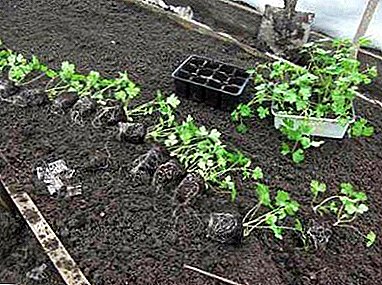 Paper cups, in which the seedlings were cultivated, are cut lengthwise, the plants are carefully removed from them, holding the parsley by the stem, taking care not to disturb the soil ball. Only then the seedlings are lowered into the wells, powdered, compacted, irrigated.
Paper cups, in which the seedlings were cultivated, are cut lengthwise, the plants are carefully removed from them, holding the parsley by the stem, taking care not to disturb the soil ball. Only then the seedlings are lowered into the wells, powdered, compacted, irrigated.In cloudy weather, the landing is carried out in the morning, and on sunny in the late afternoon. For the safety of the whole process for crops, the seedlings stop watering a few days before the procedure (applicable only to young seedlings).
- For 1 hour or 1.5 hours before placing in the ground, the parsley is plentifully irrigated, so that the earth lump is very wet and does not disintegrate when transferred to a new place.
- Plastic cups with seedlings are gently turned over to get sprouts with a lump, and they are taken out of the culture cassettes using a spatula - a spatula, and from common boxes - with a planting shovel, undermining and removing the plants with earth lumps.
We offer to watch a useful video on how to transplant parsley seedlings in open ground:
Further care of plants
Seedlings of parsley, planted on open beds, are regularly weeded, watered, fertilized. Irrigation cultures are recommended in the early morning or in the evening. Nutrients contribute when parsley has 3 large leaves, and also at a cut of culture. To obtain a lush green mass requires the introduction of complete mineral fertilizer with nitrogen.
Custom roll-out method for home conditions
The method of cultivation of parsley in roll-ups is suitable for fast shoots. Seeds - seedlings can be kept in paper for a long time, which is of great help in the case when the weather is not suitable for planting seedlings in the ground. Another advantage of the method is space saving.
The technology of planting seeds at home using roll-ups:
- Take a plastic bag, the width of which is slightly larger than that of a roll of toilet paper. Leave it on a flat surface.
- Spread on the package three layers of toilet paper: the first - on the top of the packet edge, the second - in a level with the bottom edge, the third - on the top edge.
- In the tank make a solution by adding to the water (0.5 l) the usual hydrogen peroxide (1 large spoon). Moisten paper sheets.
- Lay out the seeds, retreating from the top edge of 0.5 mm (the distance depends on the size of the seed).
- Cigarette with planting material is rolled into a roll, placed in a container with water. At the bottom of the container is poured all the same peroxide solution that was used to wet the paper.
- Sachets are signed. A cellophane bag is put on the entire container with roll-ups in order to retain moisture, left in a warm place (even in a shaded place) until germination.
Seedlings will appear very quickly. You can keep the seedlings until convenient for planting beds.
Below you can watch a video on how to grow parsley seeds of the roll-up method:
Problems and difficulties, their solutions
Important conditions for proper cultivation of parsley seedlings are taking into account the growing season of crops, providing optimal conditions for the development of greenery, in particular, proper lighting, calculating the time of sowing of seeds (depends on the variety). Without taking into account these components, you can not get quality seedlings.
A common misconception when growing seedlings - cultivating them in one container because of the savings in space. At first, like, strong roots are formed at shoots, which is undoubtedly useful. But at the same time there is a big problem, because the saplings will have to be divided as they grow, it will be a stressful situation for the crops, since with such a procedure it is practically impossible to damage the roots.
Transplanting also requires adaptation. For early varieties, this may provoke a delay in the ripening of the entire crop. It is advisable not to save, but immediately use for planting, for example, peat cups, tablets, separate paper containers, the use of which will not harm sprouts.
Important! Excessive growth of saplings is often constrained by less watering, but this is acceptable only for young shoots. For formed seedlings, limiting irrigation is stress.
In the darkened rooms install additional lighting lamps, only in this case, the seedlings will develop well.
Growing seedlings is a laborious process. But with proper cultivation, you can get strong shoots. Properly carried out the procedure of planting crops in open ground - a pledge of excellent adaptation of plants in the beds. A big harvest of juicy early greens will be a reward for the gardener for their hard work.


 Paper cups, in which the seedlings were cultivated, are cut lengthwise, the plants are carefully removed from them, holding the parsley by the stem, taking care not to disturb the soil ball. Only then the seedlings are lowered into the wells, powdered, compacted, irrigated.
Paper cups, in which the seedlings were cultivated, are cut lengthwise, the plants are carefully removed from them, holding the parsley by the stem, taking care not to disturb the soil ball. Only then the seedlings are lowered into the wells, powdered, compacted, irrigated.

